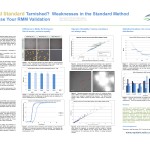 Introduction of a new Rapid Microbial Method (RMM) requires a full validation. The purpose of the validation is to prove that equivalent or better results are obtained using the new method when compared to the compendia. One assumes that the result obtained with the compendial method is absolute and is the “Gold Standard” by which to compare the new test. In reality, the compendial method exhibits a number of weaknesses that compromise the integrity of the validation. The standard requires that: 1.The media used for growth of microorganisms is consistent in formulation and performance. 2.The operators have similar abilities to accurately count the colonies that develop on the plate surface. 3.The specifications set and statistical methods used are consistent with and account for the natural variation in microbial testing. Both EU and US Pharmacopeias describe the formulation required for standard media used in microbiological testing. These formulations are followed by manufacturers, however sourcing of raw materials and preparation can result in differences in performance from manufacturer to manufacturer and lot to lot. The accuracy of the colony count depends on such factors as the patience and visual acuity of the operator(s). Colony sizes can vary from pin-point to large to spreading growth that covers the agar plate surface. Thus, colonies can be individual or may coalesce to form a merged colony containing 2 or more individual colonies. Any of these factors may lead to inaccuracies in enumeration. The decision on which statistics to use during validation is difficult. In the Pharmacopeias there are guidelines for testing accuracy where recoveries of >70% or 50-200% of the control media are stated. Improper use of statistical methods can result in the failure of a validation for not meeting requirements for accuracy and precision. The studies presented here investigate potential weaknesses of the Compendial “Gold Standard” method that may compromise validation of new technologies.
Introduction of a new Rapid Microbial Method (RMM) requires a full validation. The purpose of the validation is to prove that equivalent or better results are obtained using the new method when compared to the compendia. One assumes that the result obtained with the compendial method is absolute and is the “Gold Standard” by which to compare the new test. In reality, the compendial method exhibits a number of weaknesses that compromise the integrity of the validation. The standard requires that: 1.The media used for growth of microorganisms is consistent in formulation and performance. 2.The operators have similar abilities to accurately count the colonies that develop on the plate surface. 3.The specifications set and statistical methods used are consistent with and account for the natural variation in microbial testing. Both EU and US Pharmacopeias describe the formulation required for standard media used in microbiological testing. These formulations are followed by manufacturers, however sourcing of raw materials and preparation can result in differences in performance from manufacturer to manufacturer and lot to lot. The accuracy of the colony count depends on such factors as the patience and visual acuity of the operator(s). Colony sizes can vary from pin-point to large to spreading growth that covers the agar plate surface. Thus, colonies can be individual or may coalesce to form a merged colony containing 2 or more individual colonies. Any of these factors may lead to inaccuracies in enumeration. The decision on which statistics to use during validation is difficult. In the Pharmacopeias there are guidelines for testing accuracy where recoveries of >70% or 50-200% of the control media are stated. Improper use of statistical methods can result in the failure of a validation for not meeting requirements for accuracy and precision. The studies presented here investigate potential weaknesses of the Compendial “Gold Standard” method that may compromise validation of new technologies.
Monday October 06, 2025
